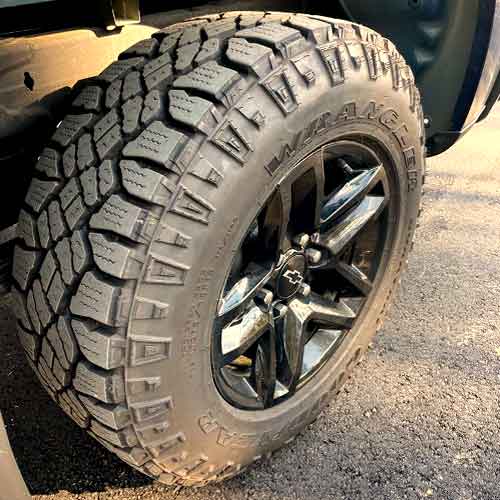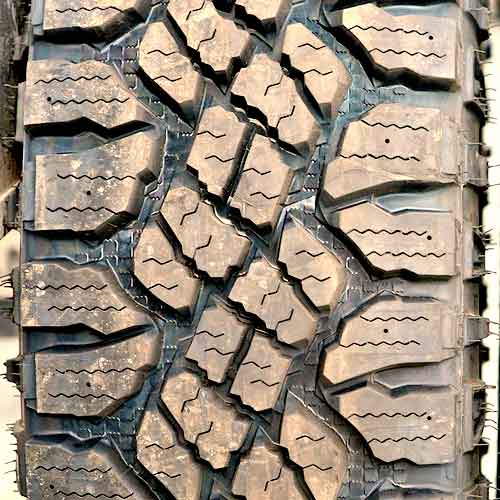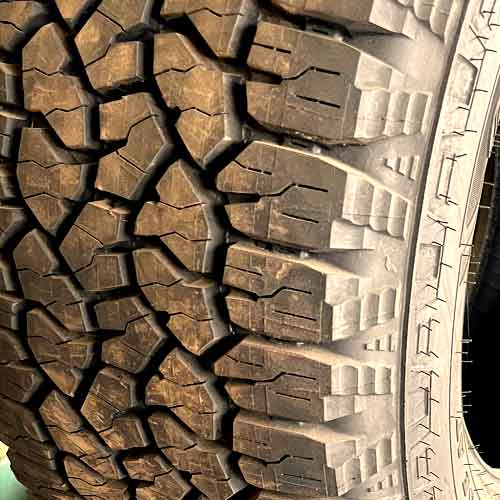The Goodyear Wrangler Duratrac is categorized in the category of all-terrain tires, just like the Goodyear Wrangler Duratrac, though Duratrac has a design which tells it comes in rugged terrain category (with it’s thick sides and closed up central tread making it a hybrid/RT).

Being a tire engineer, in my opinion, the Goodyear Workhorse A/T offers a very stable steering response along with both directional and lateral grip on pavements. The tire is also very light in weight and provides great fuel efficiency. On the other side, the Goodyear Duratrac is one of the lightest tire that you can get in rugged terrain category. So the tire does pretty great, where it offers superior off road traction, though it’s sidewalls scare me, especially on rocky trials.
Table of Contents
Tire classification
The Wrangler Duratrac
- Offers 15 to 22″ rim sizes.
- Speed rating: Q, S, P, and T.
- Load rating goes up to F.
- Lightest size is 35 lbs while the heaviest 68 lbs.
- Tread depth seen on most sizes: 16/32″, where maximum seen is 18/32″.
- 3PMSF and M+S ratings available on all sizes.
The Goodyear Workhorse AT
- Sizes available: 15 to 22 inches.
- Speed ratings available: R, S, T and some have H (much better rating in comparison).
- Load Ratings: Sizes are offered with SL, XL, D or E (only).
- Weight range: 29 to 53 lbs.
- Tread depth: 12/32″, 15/32″ (one size, LT 215/85R16 is seen with 16/32″).
- 3PMSF and M+S ratings available on all sizes.
Tread Features
Let’s talk Goodyear Duratrac first, as it’s features are more prominent, and need to be understood for proper comparison.

Starting from the sides, this tire offers pairs of shoulder lugs (joined by foundation rubber underneath) with wild void surrounding space.
These wider gaps although don’t carry conventional stone ejectors, they do have what Goodyear calls, Tractive Groove Technology (it’s those biters planted in the tread voids).
The wider groove separate the smaller central lugs in a very noticeable manner.
Here the blocks are squared off with zigzag edges providing a lot of chewing power.
These blocks are also joined with each other from underneath just like the shoulder lugs.
These blocks are not stud-able and carry less aggressive siping design, though it’s quite enough for directional traction.
Now let’s come to Goodyear Wrangler Workhorse AT, where it’s sides are not as aggressive as GY Duratrac.

Here the shoulder lugs are not stud-able and don’t carry wave-like sping pattern, though towards inner edges, they feature notches and towards sidewalls, they have stepped edges.
So although they are not as serrated, each block is still staggered on itself.
But where the Goodyear Duratrac has huge surrounding voids the Wrangler Workhorse provides very small lateral gaps and even those have ridges placed in between.
Towards the middle the tire makes 4 longitudinal grooves, where the inner two channels have more curves and sharpness to them.
This is because of the curved ribs here, though all of them look quite similar as they are all shaped like a “horses shoe”.
For Your Info: The tire also carries some of the features from Goodyear Duratrac, like its grooves also have a mini version of tread blocks, and all the ribs here joined together by foundations underneath.
Durability
Both the Goodyear Wrangler Duratrac and the Workhorse AT are not going to impress in this section, as they are both very weak internally.
Here although both tires offer 2 ply polyester cover, with 2 steel belts running on top, the Duratrac has 2 more layers of nylon on top, whereas the Workhorse does not offer any.
So Duratrac is stronger here, but still overall both tires are weak for their category.
So, although with that the durability is compromised, the tire also reduces a lot of it’s weight which improves it’s steering response on roads.
For Your Info: BF Goodrich KO2 stays toughest tire in all-terrain category, check it out here.
Highway Traction
Off road tires compromise a little on streets, as they lack in giving better steering feedback as well as directional and lateral traction.
Let’s see why.
Dry Grip
On pavements, the Goodyear Duratrac would lack a little in traction because of it’s limited footprint. That’s why the tire only goes up to T, whereas the other goes up to H.
But even T for a hybrid tire is pretty good, and that’s because of the tire’s rounded contact patch which provides better directional stability on higher speeds.
But still the Goodyear Workhorse with closed up blocks arrangement shows better effectiveness.
Although the tire has rounded contact patch like the DuraTrac, it’s inner construction consists of fewer polymer layers, the overall lower weight of the tire contribute to better steering responsiveness and handling stability with less stiffer sidewalls.
Dry Handling
Handling of a tire tells how well it corners, and here shoulders of a tire meet the road the most.
The Goodyear Workhorse AT like I showed you in the tread section offers a compact shoulder lugs which are joined together, so the these lugs meet with the road very efficiently where the shoulder connector provide them with rigidity.
On the other side, the Goodyear Duratrac has very open shoulder lugs, and they don’t offer much road exposure, so they suffer here a little bit.
Communication Response
The Goodyear Workhorse AT has a very communicative design where it performs great on dry, though same can’t be said about it’s wet performance as you’ll see below.
The Goodyear Duratrac on the other hand, is not that vocal on dry as the tire over-steers more in comparison, but its response on wet is good enough.
(On wet highways, the Wrangler Duratrac with its joined shoulder lugs offer a better balance between over and under steering).
Wet Pavement Traction
On wet, there are 2 main points to look for, one is traction and the other is hydroplaning.
Let’s discuss these both.
Wet Grip
Wet grip is achieved by siping as they are the ones which wipe water away. The sipes basically provide slits in the grooves, and they vacuum in the water to clear it off. So the rubber of the tire effectively meets with the road.
But here siping design is also very crucial, so even though Wrangler Duratrac does not offer better contact patch, it’s sipes are interlocking which provide better efficacy.
Moreover, the tire offers softer sipping pattern so they are more flexible to move and this contributes to overall wet traction a lot.
The Goodyear Wrangler Workhorse although offers a nice soaking tread, it’s siping design isn’t that effective overall.
Hydroplaning
Hydroplaning is when a thin layer of water don’t allow tire to meet with the road and it start to float. It’s main cause is higher speed.
So here water escaping is important, and the balder the tire is, the better the water evacuation.
Now, both tires offer good enough channels for water evacuation, but still out of the two, the outer longitudinal channels on Wrangler Duratrac are wider, so they provide better resistance to aquaplaning.
The Wrangler Workhorse AT on the other side although offers interconnected web of grooves as well, they are not either as deep or wide, so water is not escaped here in a better way (in comparison).
Ride Comfort
In overall ride quality, on road noise is a key component, besides tire’s ability to soak up the bumps.
And although both tires provide a good efficiency in consuming the imperfections of the road (as both provide a spongy rubber composition), the Goodyear Wrangler Workhorse is still superior as it offers very silencing grooves where it’s shoulder gaps (with ridges in between), don’t allow the sound (air) to come in and hit the tread walls.
The Wrangler Duratrac on the other hand, is very loud and besides providing pitch sequencing, it generates a lot of groove resonance, that’s why the tire is very loud.
For Your Info: With pitch sequencing, the tread blocks differ from each other in terms of geometry and when air hits them, they generate different tones (and waves cancel out each other).
Winter Capabilities
Winter performance is calculated by measuring the tire’s accelerations, stopping power and cornering ability on both slick and deep snow, as well as ice.
Here both tires get the acceleration part covered as both of them offers peak mountain snowflake rating (3PMSFR), which is basically an acceleration test.
In terms of braking and cornering the Goodyear Wrangler Workhorse AT is better, while with deeper snow the Wrangler Duratrac shows better effectiveness.
The GY Duratrac also offers stud-able lugs (on LT sizes, where you can put 16 of these studs) and they offer great traction on icy terrains.
Rocky Areas
On rocks, durability is a big one and although both tires offer 2 ply sidewalls, the Duratrac still at least offers sidewall lugs that provide extra protection.
It’s lugs also act as biters and provide extra footprint when you lower the air pressure of the tire.
The Goodyear Workhorse on the flip side, is lacking here with it’s smaller groove mouth, though its performance is not too bad considering other less aggressive AT tires.
The tire provides softer ribs with supports beneath, so these lugs stay rigid and at the same time stick on rocky surface where the horse shaped ribs with notches chew on the surface.
The tire also offers special composition which makes it’s rubber cut resistance just like the Wrangler Duratrac, so you can move on gravel with higher speeds.
Muddy Areas
Mud is not AT friendly, but here the Goodyear Duratrac is not AT.
As explained it’s a hybrid, having mud tire’s shoulder lugs.
So the tire provide superior grip on this terrain, where the wide surrounding tread voids provide straight-forward path for mud to leave out faster.
Mud evacuation is really important for this type of terrain, ans so that’s the main reason why the Goodyear Workhorse AT is not able to provide any kind of capability here.
It’s close up grooves simply gets filled with mud very quickly.
And its shoulder lugs where are joined to each other with connectors, don’t allow the sideways removal of the mud.
Sand
Sand is a tough one, and here there are 2 main factors, tire’s structure and tread’s footprint.
And considering both, it makes sense why the Goodyear Workhorse AT does so much better.
The tire is very light so that’s a plus on slopes, it offer ton of footprint, so you get to make a lot of sand to rubber exposure, and it’s tread is flexible so that area is enhanced especially with lowered air pressure.
The Goodyear Duratrac on the other side, is also not too bad, as the tire is also very soft and offers sidewall lugs with provide ample footprint.
But with slightly larger weight the tire would lag on inclines.
Ending Note
Goodyear Workhorse AT is a good all rounder tire, which offers very great steering feedback on highways, but only on dry, as on wet, the tire lags slightly with it’s inefficient siping pattern.
On the other side, the Wrangler Duratrac does okay in wet conditions, and provide superior grip off road, but it’s not as comfortable on highways, and lacks when it comes to fuel efficiency and tread wear.
Though both tires offer good enough tread life and wear warranty overall.